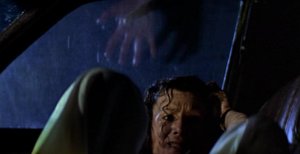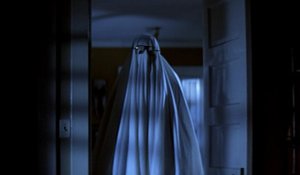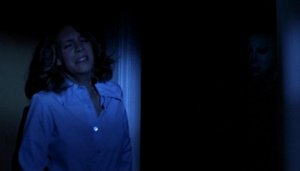
With only student films to his name, USC graduate John Carpenter had achieved minor acclaim with his exploitation thriller Assault on Precinct 13. For his next project, a producer had approached him about writing and directing a movie about ‘a babysitter being stalked by the boogeyman.’ Little did anyone involved know what kind of impact that film would eventually have on not only the horror genre but also the industry in general. Made with little money and no studio backing, the resulting effort – Halloween – would become one of the most successful independent motion pictures of all time and would launch the careers of not only Carpenter but also his lead actress, Jamie Lee Curtis. Despite the countless sequels and imitators draining the formula dry, Carpenter’s original would remain one of the most popular horror movies of all time.
 Halloween night, 1963; A figure slowly makes its way towards a house in a quiet suburb and sneaks over to a window to peer inside. A young couple make out on the couch whilst the girl’s parents are out for the evening. Eventually, the heavy petting gets too much for them and they quickly head upstairs. The figure quietly enters the house and takes a large carving knife from out of a kitchen drawer before removing a mask from off the wall and placing it over its face. A moment later, the boyfriend (David Kyle) heads down the stairs and out of the front door. Carefully, the figure walks up towards the room where the young girl, Judith Myers (Sandy Johnson), is sat topless in front of the mirror, preparing for bed. The girl turns around just in time to see the figure as it brings the knife and, repeatedly stabbing her until she collapses on the floor. Making its way quickly back down the stairs and out of the door, the figure is greeted by a couple returning home, who pull the mask off to reveal that the killer was Judith’s six year old brother, Michael (Will Sandin).
Halloween night, 1963; A figure slowly makes its way towards a house in a quiet suburb and sneaks over to a window to peer inside. A young couple make out on the couch whilst the girl’s parents are out for the evening. Eventually, the heavy petting gets too much for them and they quickly head upstairs. The figure quietly enters the house and takes a large carving knife from out of a kitchen drawer before removing a mask from off the wall and placing it over its face. A moment later, the boyfriend (David Kyle) heads down the stairs and out of the front door. Carefully, the figure walks up towards the room where the young girl, Judith Myers (Sandy Johnson), is sat topless in front of the mirror, preparing for bed. The girl turns around just in time to see the figure as it brings the knife and, repeatedly stabbing her until she collapses on the floor. Making its way quickly back down the stairs and out of the door, the figure is greeted by a couple returning home, who pull the mask off to reveal that the killer was Judith’s six year old brother, Michael (Will Sandin).
Fifteen years later and on the night before Halloween a car heads through the rain towards the Smith’s Grove Sanitarium. Nurse Chambers (Nancy Stephens) is driving psychiatrist Dr. Loomis (Donald Pleasence) to attend a hearing to decide the fate of his patient, Michael (Nick Castle), who has not spoken a word since that night. But as they approach the building they discover that the patients are loose on the grounds unsupervised. When Loomis orders her to stop and gets out to investigate, a figure jumps on top of the car and begins to bang on the window until the nurse gets out. Jumping behind the wheel, the car speeds away, leaving Loomis frantically screaming about the ‘evil’ being gone. The following morning in the town of Haddonfield, Illinois, virginal teen Laurie Strode (Curtis) steps outside and walks up towards the old Myers home where she has been instructed to drop off a key. Inside the house, a shape watches as Laurie walks away with a young boy called Tommy Doyle (Brian Andres), her babysitting charge.
 At the institution, Dr. Loomis and the hospital’s administrator, Dr. Wynn (Robert Phalen), argue about the next course of action. Loomis insists that Michael is heading back to Haddonfield but Wynn states that it is too far from him to travel, although he has obviously been given driving lessons. Meanwhile, after school Laurie meets up with her friends, Lynda (P.J. Soles) and Annie (Nancy Loomis), to discuss their plans for the evening. Laurie states that she has to baby-sit, as does Annie, but the latter still plans on meeting up with her boyfriend. But a car soon arrives in the neighbourhood with Smith’s Grove markings and the driver begins to stalk the young girls as they head around town. Determined to stop Michael from repeating the crimes of his youth, Loomis heads to Haddonfield to warn the authorities and bring his reign of evil to an end.
At the institution, Dr. Loomis and the hospital’s administrator, Dr. Wynn (Robert Phalen), argue about the next course of action. Loomis insists that Michael is heading back to Haddonfield but Wynn states that it is too far from him to travel, although he has obviously been given driving lessons. Meanwhile, after school Laurie meets up with her friends, Lynda (P.J. Soles) and Annie (Nancy Loomis), to discuss their plans for the evening. Laurie states that she has to baby-sit, as does Annie, but the latter still plans on meeting up with her boyfriend. But a car soon arrives in the neighbourhood with Smith’s Grove markings and the driver begins to stalk the young girls as they head around town. Determined to stop Michael from repeating the crimes of his youth, Loomis heads to Haddonfield to warn the authorities and bring his reign of evil to an end.
Halloween is the perfect example of Carpenter’s talents as a director, which would sadly become obscured by mediocre efforts during the latter half of his career. Shot in lush widescreen and with fluid use of the steadicam (then a relatively new tool), the cinematography plays a large part in the creepy atmosphere that the movie creates, with Michael Myers subtly appearing at the corner of the screen. One of the film’s greatest assets is its simple-yet-effective score, performed by the director, which generates tension and alerts to the possible danger without the antagonist even being on screen. Halloween’s noted lack of blood is made up for with the perfectly staged sequences in which Michael seems to disappear into thin air whilst he stalks his victims, making him seem to be more like a force of nature than an actual human being.
 Carpenter’s decision for him to script the dialogue for Loomis, whilst regular collaborator Debra Hill wrote the teenage characters, was an inspired move, as there is a distinct difference between the authority figures and the youngsters. The cast are also impressive; particularly screen veteran Pleasence and newcomer Curtis, who shines as the ‘final girl.’ Whilst her co-stars are equally impressive, Lynda’s overuse of the word ‘totally’ soon becomes irritating and it is almost a relief when she is killed (in one of the film’s most effective scenes). With no dialogue and his face permanently obscured behind a mask, Castle makes for a suitably creepy villain, with impressive body language that somehow reveals so much about the character with just the tilt of his head. Over the years, Halloween has been hailed as a masterpiece by critics and fans alike. But does the movie deserve this title? Totally!
Carpenter’s decision for him to script the dialogue for Loomis, whilst regular collaborator Debra Hill wrote the teenage characters, was an inspired move, as there is a distinct difference between the authority figures and the youngsters. The cast are also impressive; particularly screen veteran Pleasence and newcomer Curtis, who shines as the ‘final girl.’ Whilst her co-stars are equally impressive, Lynda’s overuse of the word ‘totally’ soon becomes irritating and it is almost a relief when she is killed (in one of the film’s most effective scenes). With no dialogue and his face permanently obscured behind a mask, Castle makes for a suitably creepy villain, with impressive body language that somehow reveals so much about the character with just the tilt of his head. Over the years, Halloween has been hailed as a masterpiece by critics and fans alike. But does the movie deserve this title? Totally!

7 Responses to Halloween (1978) Review